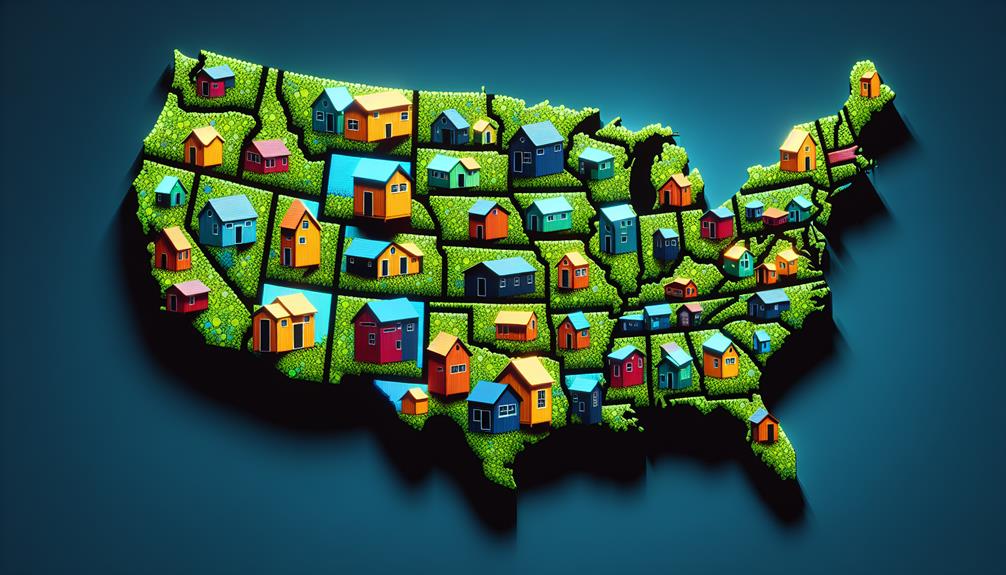Navigating the patchwork quilt of tiny home regulations across the United States can be as intricate and varied as the homes themselves. You'll find that while some states roll out the welcome mat for these minimalist abodes, offering a haven for those looking to downsize and simplify, others erect a labyrinth of zoning laws and building codes that can turn the dream of tiny house living into an odyssey of red tape.
As you weigh the charm of a pared-down lifestyle against the complexities of legal compliance, it's crucial to arm yourself with knowledge about where your tiny home ambitions can take root without the fear of uprooting. The key lies in understanding which states embrace this growing movement and how they accommodate the unique needs of tiny house residents.
Stay tuned, and you'll discover the roadmap to planting your tiny home dreams on the right soil.
Key Takeaways
- Different states have varying building codes and zoning laws for tiny homes.
- No state completely prohibits tiny houses, but they impose different degrees of restrictions.
- California, Maine, Texas (Austin and Spur), Pima County in Arizona, and Washington offer favorable environments for tiny homes.
- Zoning laws dictate where and how tiny houses can legally exist, and compliance with building codes is necessary to avoid legal issues.
Understanding Tiny House Legality
To navigate the complexities of tiny house ownership, it's essential to understand the specific legal framework and zoning regulations that govern these dwellings in your state. Building codes and zoning laws vary widely, impacting where you can situate your tiny home and what designs meet safety standards.
Some states have embraced tiny house communities, offering a blueprint for legal compliance and community development. States like California, Maine, Texas, Arizona, and Washington provide a more favorable regulatory environment. However, no state entirely prohibits tiny houses; they simply impose varying degrees of restrictions.
Researching state-specific regulations, engaging with local councils, and meticulously planning for compliance are pivotal steps. This analytical approach ensures your tiny home aligns with legal expectations, fusing innovation with adherence to the law.
State-by-State Tiny House Regulations
Understanding the legal framework for tiny homes sets the stage for a closer look at the regulations that vary from one state to another. Your navigation of the state-by-state tiny house regulations reveals a patchwork of laws and zoning rules:
- California: Pioneering with numerous tiny home communities, offering a supportive environment for innovative housing solutions.
- Maine: Provides leniency for homes under 400 square feet, exemplifying adaptable regulations that cater to the tiny house movement.
- Texas: Cities like Austin and Spur showcase progressive policies with established communities embracing tiny living.
- Arizona & Washington: Both Pima County in Arizona and the state of Washington offer favorable zoning for tiny homes on foundations, reflecting a growing acceptance of alternative living spaces.
Informed by these facts, you're equipped to delve into the intricacies of tiny home living within these forward-thinking regions.
Tiny House Zoning Considerations

When navigating the landscape of tiny house ownership, it's crucial to consider zoning laws that dictate where and how these dwellings can legally exist. You must examine the local zoning regulations that often specify the minimum square footage for residences. Tiny house zoning considerations vary widely; some areas may have more relaxed standards, while others impose stringent requirements.
For instance, while tiny houses on wheels may be classified differently from static homes, both types must comply with the relevant codes. In Delaware, titles are mandatory for tiny homes on wheels within 30 days of purchase, reflecting the legal intricacies you might face.
Always conduct thorough research or consult with local authorities to ensure your tiny home meets all regulatory demands, avoiding potential legal complications down the line.
Building Codes for Tiny Homes
As you navigate tiny house zoning laws, it's equally important to ensure your home adheres to the specific building codes in your area to maintain legality and safety. When considering building codes for tiny homes, you're dealing with a complex set of regulations that demand thorough understanding and compliance. Here are key points to consider:
- Building codes vary by location—check state, city, and county regulations.
- Compliance with these codes is necessary to avoid legal issues.
- Different rules may apply to wheeled homes versus stationary tiny homes.
- Adherence to minimum size requirements, including ceiling heights, is crucial for safety.
Always reach out to your local council for detailed information on the regulations impacting your tiny home project.
Challenges in Tiny House Living

You'll encounter zoning restrictions that can significantly impact where you can place your tiny home.
Access to utilities may also present complications, as not all areas are equipped for the unique needs of tiny houses.
Moreover, adjusting to the tiny house lifestyle involves a curve, requiring you to embrace a more minimalist way of living and clever space management.
Zoning Restrictions Impact
Navigating the complex web of zoning restrictions is a crucial step for tiny house enthusiasts, as these regulations dictate the feasibility and legality of tiny home placements across various jurisdictions. The zoning restrictions impact your plans significantly, and understanding them is non-negotiable when building a tiny dwelling.
- Local Zoning Laws: Check if the city within your chosen locale permits tiny houses as primary dwellings or only as ADUs (Accessory Dwelling Units).
- Compliance with Codes: Ensure your tiny home meets state-specific building codes, including size and ceiling height requirements.
- Wheeled Homes: Identify if your state has restrictions on wheeled tiny homes, which might be categorized differently.
- Innovative Communities: Research areas with innovative zoning laws that support the tiny house movement for a smoother transition into tiny living.
Utility Access Complications
Securing utility access presents a significant hurdle for tiny house residents, often requiring innovative solutions to connect with essential services like water, sewage, and electricity. As you explore tiny home-friendly states, you'll find that utility access complications can vary widely due to differing laws regarding tiny homes. Navigating the maze of permits and meeting local utility connection requirements demands a proactive approach.
Consider the potential need for composting toilets, rainwater harvesting systems, or solar power as sustainable alternatives. Zoning regulations and local ordinances play a pivotal role in the feasibility of these utilities.
Ultimately, your ability to live comfortably in a tiny home hinges on a mix of creativity, compliance, and a thorough understanding of both technological options and legal frameworks.
Lifestyle Adjustment Curve
While securing utility access is a pivotal step in establishing a tiny home, adapting to the lifestyle adjustment curve presents its own set of unique challenges.
Living in a tiny space requires a significant shift in habits and possessions. You'll be part of a movement that prioritizes sustainability and innovation, but you'll also face practical and legal hurdles.
Here are four key aspects of the lifestyle adjustment curve you'll encounter:
- Simplifying possessions to fit a reduced living space.
- Navigating zoning laws and building codes specific to tiny home living.
- Designing versatile areas within your home to maximize functionality.
- Budgeting for the unique costs associated with constructing and maintaining a tiny house, including energy efficiency and suitable materials.
Embrace these challenges with creativity and strategic planning to thrive in your tiny home.
Future of Tiny Homes in Legislation

As legislation evolves, many states are increasingly recognizing the potential of tiny homes as a solution to housing affordability and environmental concerns. The future of Tiny House Laws across states in the US seems poised for growth, with more jurisdictions considering them as viable accessory dwelling units. However, you'll need to stay informed about the dynamic legal landscape, as it varies significantly from one state to another.
| State | Favorable Regulation | Specific Considerations |
|---|---|---|
| California | Yes | Zoning, Size Limits |
| Texas | Yes | Land Use, Utility Hookups |
| New York | Limited | Building Codes, Location |
Understanding these nuances is crucial for compliance and to leverage the innovation that tiny homes represent. Keep engaging with local councils to navigate these laws effectively.
Frequently Asked Questions
Which State Is Most Tiny Home Friendly?
You'll find California most tiny home-friendly, overcoming zoning challenges with progressive community initiatives and embracing off-grid living, indicative of its innovative spirit and objective support for alternative housing solutions.
Where in the US Are Tiny Homes Legal?
You're navigating a patchwork of legality; tiny homes are permitted across diverse U.S. regions despite zoning challenges. Some states champion off-grid living and community developments, fostering innovation in compact, sustainable habitats.
What States Will Pay You to Build a Tiny House?
You'll find tiny house incentives and relocation grants in progressive locales promoting living simplicity programs. Research specific states for opportunities, as offerings vary and are often tied to innovative community development initiatives.
What Is the Cheapest State to Buy a Tiny House?
You're eyeing tiny houses, but zoning challenges, financing options, and climate considerations weigh heavily. Analytically, Texas or Maine are your best bets for affordability, with supportive laws and communities fostering innovative, cost-effective tiny living solutions.
Conclusion
You might worry that navigating tiny home regulations feels daunting, but remember, states are increasingly recognizing their value.
By staying informed on state-specific laws and zoning requirements, you'll find that many places, like California and Texas, are quite welcoming.
Despite some challenges, the tiny house movement is gaining legislative attention, promising a more standardized future.
Embrace the journey, knowing that with diligent research, your tiny home dream is achievable and sustainable.

